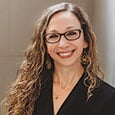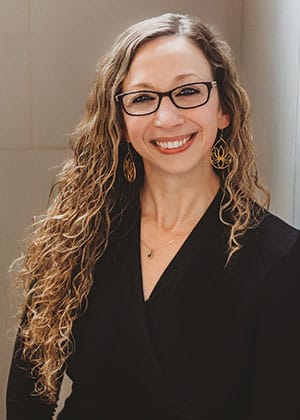 Erin Althen approaches every day as a new opportunity to connect with people and spread joy through music. Whether rehearsing with students at Westhill High School in Syracuse, New York, catching up with a mentor, or working with a colleague to build a regional student band from scratch, she looks for ways to lift people up and bring them together. She has taught in the Westhill Central School District for 21 years and conducts the high school’s Wind Ensemble, Pit Orchestra, Jazz Lab, and Brazilian Percussion Ensemble. This spring, she received the New York State Band Directors Association Outstanding Band Director Award.
Erin Althen approaches every day as a new opportunity to connect with people and spread joy through music. Whether rehearsing with students at Westhill High School in Syracuse, New York, catching up with a mentor, or working with a colleague to build a regional student band from scratch, she looks for ways to lift people up and bring them together. She has taught in the Westhill Central School District for 21 years and conducts the high school’s Wind Ensemble, Pit Orchestra, Jazz Lab, and Brazilian Percussion Ensemble. This spring, she received the New York State Band Directors Association Outstanding Band Director Award.
When did you first pick up a baton in front of a band?
My high school band director, Tom Johnston, gave me the opportunity. In my sophomore year at Farmington High School (CT) I decided to be a band director. I knew I wanted to become a teacher but was not sure what I would teach. Like so many future directors, I lived in the band room during high school. One day when I was hanging out during study hall, Mr. Johnston came in with a set of scores. He had been called to a meeting in the counseling center and asked me to run a 35-minute lesson to a mixed group of freshmen from the Symphonic Band. I looked at the scores and jumped in. I fell in love with teaching music on the spot.
That year, my father gave me a Jethro Tull songbook, and I loved playing from it. One day as I was practicing, Mr. Johnston stuck his head in and said, “You should be a band director.” I said, “I think I should, too,” and that was it. That moment stands out so clearly as a turning point in my life.
Did you ever waver and think of doing something else?
I absolutely knew what I wanted to do, although every band director has many gigs, hobbies, and outside interests. We are natural teachers in all sorts of activities. Band directing is at the center of my life and career, and there has never been a moment when I didn’t want to do this. I love leading the Syracuse Youth Wind Symphony and loved running a prenatal and postnatal yoga business for mothers. I wrapped up the yoga business when I became Director of Bands at Westhill High School because it was just too much. Band directing has always been the thing that lights me up the most.
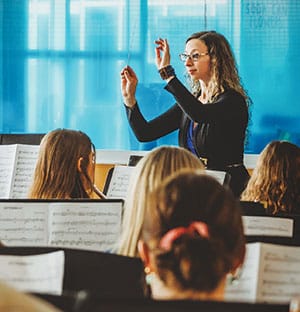 How prepared did you feel when you started teaching?
How prepared did you feel when you started teaching?
I was lucky to do my student teaching at Westhill, and began a one-year master’s program the day after receiving my undergraduate degree at Syracuse University. By Thanksgiving break, I missed the kids from my student teaching and stopped in to visit. That fall, there had been an additional director hired at Westhill who was not going to finish out the year. My host teacher asked if I knew anybody to fill the position for the rest of the year. All of my friends had a job or were in the same intense master program as I was. John Laverty, my mentor and Director of Bands at Syracuse said, “You do these master’s programs to become strong enough and good enough to get the gig. You have a chance to get the gig. We will support you in any way you need to make this happen.” That was 21 years ago.
I sometimes think back to those early years. As a young teacher you have such lofty goals and think if the kids work their hardest and everything comes together, we can play a particular difficult piece of music. The biggest hurdle is learning how to program. You have to see students as they are and meet them at that level, picking repertoire that fits them and challenges them. As a young musician and teacher, I always had a phenomenal network of mentors and colleagues I could contact.
What lessons from your mentors still come to mind as you teach?
John Laverty cared deeply about what students needed. He gave me so many extra opportunities, whether it was leaving a score on my chair and inviting me to sit in on a rehearsal I might not have been a part of or checking in to see how I was doing. He taught me the value of true, deep caring about students as musicians and individuals. I continue to connect with him to this day.
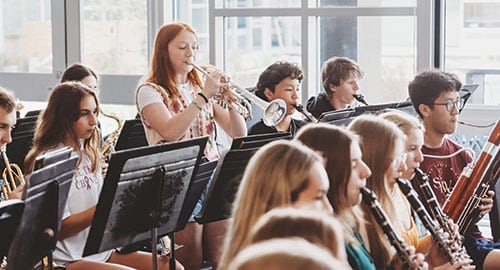
How do you approach score study?
Investigating repertoire is the most challenging aspect of teaching music. We are so lucky to have complete freedom to design our curriculum. Score study for me is a journey that starts with a light perusal of the music and researching the composer and piece. I want to get the music into my ear. I go through the music in layers and start by trying to map out the form of a piece. I have had 21 student teachers and one of my favorite lessons for them covers score study.
We start by going through all of the layers: form, instrumentation, the melodies and harmonies, dynamics, articulations, styles, and various tempi. I map out the entire work on a single page. Sometimes I use colors, labels, and post-its. Distilling the piece into one map that I can share with students has a big impact on how I rehearse.
How do you select music for your ensembles?
In programming, I look for a beautiful way to honor our traditions and histories while also including diverse programming, both for the Syracuse Youth Wind Symphony and my school wind ensemble. I strive to program a wide range of composers including those who might have been underrepresented in the past or have not had their voices heard. I am so fortunate to teach within such a strong music program at Westhill and co-conduct the Syracuse Youth Wind Symphony. With the privilege of programming such great ensembles, I can help to be an amplifier. It feels like a deep honor. When programming, I make sure that rather than doing what I’ve always done, I try to learn about more options that are out there. In our inaugural season with the SYWS, we performed Of Endless Miles and Empty Rafts by Michelle Fernandez and Symphony No. 1 Culloden by Julie Giroux. We also presented a 1914 piece by Amanda C.E. Aldridge and edited recently by Kaitlin Bove. Aldridge wrote under the name Montague Ring though she was a Black woman composer.
The question has been asked: is your repertoire a mirror for students? Are players always on the outside looking into someone else’s histories, traditions, cultures, and experience, or does the music allow students in your rehearsal to look at music that mirrors their life experiences and traditions? I feel strongly that it should do both.
When did you realize that you were good at teaching?
That’s a tough question because even after 21 years, there are moments when I think about how much I still have to learn. When I go back to a piece I programmed earlier in my career, I realize how much I didn’t understand the first time. There never was a point where I thought, “I’ve got this.” Bands will humble you in a second if you believe you know all there is to know about a piece, an ensemble, or aspect of band pedagogy. That is the beauty of what we do: we constantly evolve, assess, and grow. In the same vein, I have had invaluable mentorship and support from the beginning. My administration and community have always supported me. I never felt afraid to ask for help and guidance. I love the present, where my students are, and where the program is going.
What is your daily school schedule like?
We start at 7:40 am and end at 2:10 pm each day. There is a period each day for instructional assistance from 2:10-2:55. I typically teach four structured lessons during the day and some flex periods that might include working with the pit bands for the musical. I teach the wind ensemble third period every day. During the instructional assistance period, we have a five-day rotation with jazz lab, jazz ensemble, percussion ensemble, modern band, and the audio production and engineering club. I also get release time during the day for serving as the Fine Arts coordinator.
 As a flutist, how did you get started teaching percussion ensemble?
As a flutist, how did you get started teaching percussion ensemble?
As a student at Syracuse University, I participated in a group called Samba Laranja (Orange Samba), a Brazilian percussion ensemble. When I did my student teaching at Westhill High School, the brass and percussion instructor ran a concert percussion program and took the group out on the drum line circuit and performed standstill concerts. She probably had 12 to 15 students and all of a sudden, the concert percussion group started growing. I had 20 students and saw that number grow to 40. I decided it was untenable for concert percussion and asked the administration about purchasing a set of Brazilian Samba instruments. They were all for it and purchased a full set. I played in groups as large as 60 in college and drew on that experience and also stayed in touch with the directors.
How do you organize and run your rehearsals?
I was just talking to my student teacher about this. Rehearsals move in this arc pattern, and the arc changes if you are far away from your next performance. With more time until the concert, you can address various fundamentals. Our curriculum includes work on tone quality, blues-based improvisation, sightreading, and preparing for the state solo and ensemble festival. As the performance gets closer, rehearsals have a sharper focus on the performance repertoire.
For me, every rehearsal starts with meeting students, saying hello, and doing my best to connect with a name and eye contact. Our opening warmup helps me gauge where students are musically and personally. You detect their energy as kids walk through the door. As music educators, we assess our students throughout the rehearsal. Part of that assessment includes checking in and seeing how they are doing. We plan our lessons carefully, but in class, every next second depends on the present moment. Sometimes, students arrive, and your plans go out the window.
We talk often with students in our program about their experiences and try to describe the culture of the program. We discuss our values, and the primary value is joy. I was working with students on the school musical today, and they were exhausted. It wasn’t a day to focus on notes. It was about connecting to joy.
I hope that as they approach the band room, they can take a deep breath and exhale any thoughts or feelings weighing them down. I want them to know that someone will be ready to truly see them if they want to be seen. They will hear their names spoken and know that someone cares about who and how they are that day. Then, we get to make music and struggle and face challenges and find meaningful victories. Making music is not just checking boxes and moving on to the next thing. It is about community and engagement.
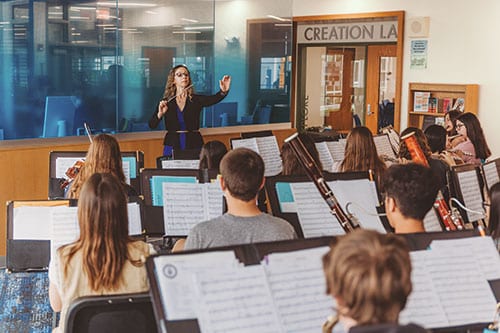
Part of evolving as a band director is learning how to give and receive with your heart, musicianship, and intellect in a beautiful way, but not give away too much of yourself in the process. It is hard to keep that balance. Band directing is not just a job: it is such a part of the fabric of who we are. At the same time, we also have families and hobbies and life outside of teaching. I have a background in yoga, mindfulness, and meditation that helps me to find that balance. Especially for those just starting out in the field, it is important to make sure that you take care of yourself as a person and not just as a director.
In our wind ensemble, which is an auditioned group, we do not have fixed chairs and rotate throughout the year. There is no hierarchy of first, second, and third chair. All of my clarinets should know how to be third clarinets and how to be first clarinets. We emphasize the importance of every seat in the band. When we talk about band family, it’s honest and authentic.
What advice do you give to your student teachers about dealing with parents?
We work to keep parents informed about what happens in the program. They hear the words and characteristics of our band culture and understand what their child is doing and why. I have learned that the key to resolving any challenge or conflict in the program is personal communication early and often. It feels safer for some directors to communicate through email. I found that if I had to have a difficult conversation with a parent, I might spend hours crafting an email. With a phone call, however, you can hear their voice, and they can hear yours. They can tell how much you care about their child, and that makes everything easier. I tell student teachers that it might be scary to call when they have a concern weighing on them, but it is so worth it.
How often do you sightread music in rehearsal that you have no intention of using in a concert?
All the time. I hope my groups play a whole bunch of notes they will never perform, from traditional pieces that don’t fit my group to music played for sightreading practice. It doesn’t feel like something special or different – it’s just part of what they do. We also encourage students to provide feedback on repertoire and suggest pieces we should play. They will hop online and find tunes they want us to consider, and we read them.
What led you to co-authoring sightreading books for students?
It came out of necessity. I was teaching a lesson to a middle school player heading to the state solo festival, and we practiced sightreading. I put a piece of music in front of her and realized that it was too different from the eight measures she would have to play at the state contest. We needed a better pedagogical tool.
I sketched out an eight-measure line of music and reminded myself that the contest manual has a grid for every instrument and playing level, showing the possible rhythms, articulations, dynamics, and range for the sightreading. I asked Brendan Van Epps, the fifth-grade director for the district, if he wanted to write sightreading books with me. He is a composer and began drafting the books, and I was the editor. It was a perfect partnership.
The result was sightreading material that illustrates exactly what you would find at any all-county or state audition in New York State down to every last detail. At the beginning, we just wanted accurate materials for our students, and then other directors started discovering that we had these books as a resource. Brendan has a publishing company, Happy Jack Music, and he started selling them.
How was the Syracuse Youth Wind Symphony formed and what have you learned from the group?
It really comes out of COVID. There is more of a range of playing experience in my wind ensemble than before the pandemic. I looked out at my ensemble and heard some students playing at a very high level. At the same time, other students had just started playing their instrument on a Google Meet during COVID.
I started talking to other area directors, who mentioned the same ability variations in their groups. I thought it would be neat to provide a youth orchestra intensive for the band students. Right next to Westhill is the West Genesee District, which also has a very strong band program. A year ago, I called their wind ensemble director, Greg Borsz, and asked if he would co-conduct this ensemble with me. He immediately said yes, and I started researching best practices for starting a program like this. I contacted another college mentor, Barbara Tagg, who is the founder of the Syracuse Children’s Chorus about how to found a 501c3 nonprofit musical organization. We met and she helped guide me through the process.
She was incredible and provided logistical assistance on finding an attorney specializing in 501c3 creation and developing a support group that would work tirelessly for the ensemble. She emphasized that creating a mission statement to explain the importance of this wind symphony would persuade others to buy in as well. She said that explaining the why for the group will make other directors encourage their students to join. From this, the SYWS mission statement became:
Musicians will perform a transformative and diverse repertoire of Wind Band music within an ensemble culture that embodies and celebrates connection, collaboration, belonging, musician-leadership, joy, and excellence in music-making. The SYWS seeks to augment, support, and serve our musicians’ outstanding school music education programs with its presence and outreach.
Last fall, we waited until marching season began to wrap up to advertise and hold auditions for the new group. Once you start something and put it out in the world, it is no longer under your control. You have to wait and see if anybody shows up. Students arrived for auditions, area directors supported the group, and the Wind Symphony held its first concert in January.
It is a complete and utter joy to stand in front of a group that makes sounds like this and rips through challenging repertoire like they do. I love watching students from across Central New York develop friendships, camaraderie, and inside jokes. Low brass kids are the same everywhere. When I head out to All-County, I see kids from different schools connecting because of the Wind Symphony. It’s a dream come true.
Erin Althen is Director of Bands and Fine Arts Department Chair at Westhill High School, in Syracuse, NY. The Westhill CSD has 1,750 students with 575 at the high school. She is the advisor to the school’s active Tri-M music honor society chapter, founder and co-conductor of the Syracuse Youth Wind Symphony, and has conducted honor ensembles and presented clinics to music educators at County, All-State, State, and National conferences. Althen earned bachelor’s and master’s degrees in Music Education with Performance Honors in Flute from Syracuse University.
All photos: © Root and Wander Photography, used with permission.
***
Syracuse Youth Wind Symphony
2023-24 Repertoire (Inaugural Season)
(alphabetical by Composer)
Series 1
Concert January 21, 2024
Americans We – Henry Fillmore
Cry of the Last Unicorn – Rossano Galante
Symphony No. 1 Culloden (Mvts I, II) – Julie Giroux
Irish Tune from County Derry and Shepherd’s Hey – Percy Grainger
Rhapsodic Celebration – Robert Sheldon
Havana Nights – Randall Standridge
Series 2
Concert March 17, 2024
On Parade: Quick March – Amanda C. E. Aldridge, ed. Kaitlin Bove
The Rakes of Mallow – Leroy Anderson
Midnight on Main Street – Brian Balmages
Halcyon Hearts – Katahj Copley
Three Irish Dances – James Curnow
Of Endless Miles and Empty Rafts – Michele Fernández
Pablo! – Richard Meyer
Series 3
Concert May 12, 2024
Beyond the Horizon – Rossano Galante
Until the Scars – John Mackey
Jazz Suite, Waltz No. 2 – Dmitri Shostakovich
Washington Post March – John Philip Sousa
English Folk Song Suite – Ralph Vaughan Williams
In Two Places – Haley Woodrow
